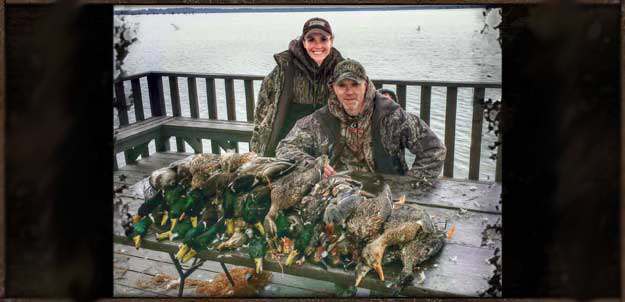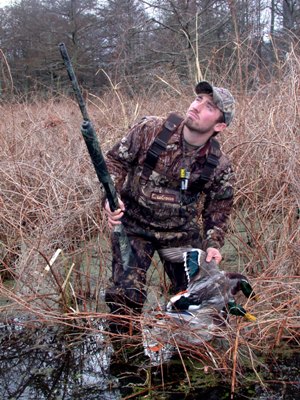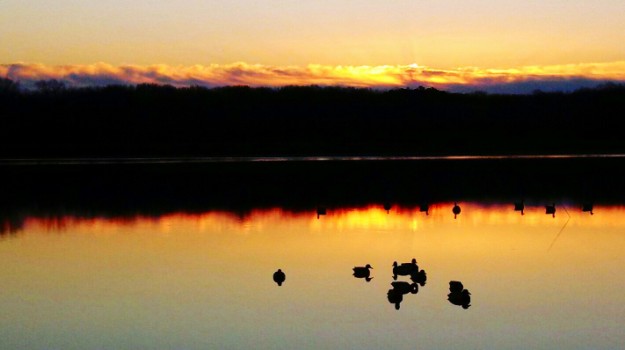
Editor’s Note: Jason Patterson from Jackson, Tennessee, has been hunting waterfowl for more than 20 years and is the original Pro Staff Manager for waterfowl on the Mississippi flyway. He primarily guides in northeast Arkansas and west Tennessee.
This past duck season as in other seasons, the mallard duck was the primary duck taken along the Mississippi flyway, although we also had a good season on pintails, canvasbacks and redheads. We get the most canvasbacks, redheads and diver ducks when we hunt on big water. Late in the season there seems to be a lot of ducks holding in Illinois, Indiana, Kentucky and Kansas - states where the snow line seems to stop during most of the season. Most of the ducks we hunt nest and raise their young in Canada and the states I’ve mentioned. These areas are usually where the ducks coming down from Canada, stop off and then depart to move from the south to the north.
 As I mentioned previously (See Day 1), we had a large migration of ducks from the north coming down the Mississippi flyway the first weekend of the 2014 duck season. I feel certain that many of those ducks got all the way down to the coast of the Gulf of Mexico; but then when warm fronts arrive, the ducks at the coast often will fly back to the snow line states. Ducks are motivated by temperature and food availability. Cold weather temperatures cause the ponds and lakes to freeze over and snow to cover the grain fields. Warm weather opens up the ponds and lakes and makes the food easily accessible to the ducks. The waterfowl refuges all along the Mississippi flyway make sure that the ducks have open water and plenty of food available as they’re flying from north to south and south to north. Duck hunting is often best in areas of waterfowl refuges.
As I mentioned previously (See Day 1), we had a large migration of ducks from the north coming down the Mississippi flyway the first weekend of the 2014 duck season. I feel certain that many of those ducks got all the way down to the coast of the Gulf of Mexico; but then when warm fronts arrive, the ducks at the coast often will fly back to the snow line states. Ducks are motivated by temperature and food availability. Cold weather temperatures cause the ponds and lakes to freeze over and snow to cover the grain fields. Warm weather opens up the ponds and lakes and makes the food easily accessible to the ducks. The waterfowl refuges all along the Mississippi flyway make sure that the ducks have open water and plenty of food available as they’re flying from north to south and south to north. Duck hunting is often best in areas of waterfowl refuges.
Many hunters spend time and effort learning to call ducks, and calling is a very important part of the game. However, one of the main reason ducks will come out of the sky and land on the water is because they see other ducks sitting and feeding on the water and hear ducks talking to each other and calling to them. The duck call I use is a Zink NBG - Nothing But Green - a single reed duck call (www.zinkcalls.com). The decoy spread that I use depends on where I’m hunting. When we’re hunting by open water, I’ll put out a large spread Avian X decoys (www.avian-x.com). Although the spread will be mainly mallards, I’ll also include a wide variety of other types of decoys besides the mallards as well as Canada geese decoys. When I’m hunting in the woods and potholes, I’ll only put out a couple dozen mallard decoys. One of the big advantages of hunting Reelfoot Lake is it has plenty of backwater areas with woods and potholes as well as big open water areas there. Around my home are several small rivers that flood, and I can hunt them around buck brush and standing timber.
To learn more about Jason Patterson you can contact him at jason@ikappaduck.com.
Day 1: ProStaffer Jason Patterson on Why Ducks Move in Both Directions During Waterfowl Season
Tomorrow: Kentucky Lake and Reelfoot Lake Have Ducks Aplenty






























